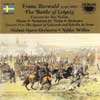Berwald Orchestral Works
Engaging disc of (mostly) rarities from Sweden’s foremost 19th-century composer
View record and artist detailsRecord and Artist Details
Composer or Director: Franz (Adolf) Berwald
Genre:
Orchestral
Label: Sterling
Magazine Review Date: 12/2003
Media Format: CD or Download
Media Runtime: 75
Mastering:
Stereo
DDD
Catalogue Number: CDS1051-2

Tracks:
| Composition | Artist Credit |
|---|---|
| (The) Queen of Golconda, Movement: Overture |
Franz (Adolf) Berwald, Composer
Franz (Adolf) Berwald, Composer Malmö Opera Orchestra Niklas Willén, Conductor |
| (The) Queen of Golconda, Movement: March |
Franz (Adolf) Berwald, Composer
Franz (Adolf) Berwald, Composer Malmö Opera Orchestra Niklas Willén, Conductor |
| (The) Queen of Golconda, Movement: Bridal Procession |
Franz (Adolf) Berwald, Composer
Franz (Adolf) Berwald, Composer Malmö Opera Orchestra Niklas Willén, Conductor |
| (The) Queen of Golconda, Movement: Ballet |
Franz (Adolf) Berwald, Composer
Franz (Adolf) Berwald, Composer Malmö Opera Orchestra Niklas Willén, Conductor |
| (The) Queen of Golconda, Movement: Folk Dance |
Franz (Adolf) Berwald, Composer
Franz (Adolf) Berwald, Composer Malmö Opera Orchestra Niklas Willén, Conductor |
| Slaget vid Leipzig (Battle of Leipzig) |
Franz (Adolf) Berwald, Composer
Franz (Adolf) Berwald, Composer Malmö Opera Orchestra Niklas Willén, Conductor |
| Estrella de Soria, Movement: Overture |
Franz (Adolf) Berwald, Composer
Franz (Adolf) Berwald, Composer Malmö Opera Orchestra Niklas Willén, Conductor |
| Estrella de Soria, Movement: Polonaise |
Franz (Adolf) Berwald, Composer
Franz (Adolf) Berwald, Composer Malmö Opera Orchestra Niklas Willén, Conductor |
| Concerto for two Violin and Orchestra |
Franz (Adolf) Berwald, Composer
Andreas Hagman, Violin Franz (Adolf) Berwald, Composer John Lörstad, Violin Malmö Opera Orchestra Niklas Willén, Conductor |
| Theme and Variations for Violin and Orchestra |
Franz (Adolf) Berwald, Composer
Franz (Adolf) Berwald, Composer John Lörstad, Violin Malmö Opera Orchestra Niklas Willén, Conductor |
Author: Guy Rickards
The Battle of Leipzig sits in Berwald’s oeuvre much as Wellington’s Victory does in Beethoven’s and the 1812 Overture in Tchaikovsky’s: a patriotic pièce d’occasion with limited musical interest (the references to God save the King are not an attempt to rewrite history but the tune was at the time – 1828 – Sweden’s national anthem) and an excuse for an outdoor firework display. In Berwald’s case, however, it proved surprisingly popular. It does show his gift for melody, but as a whole is as foursquare and stilted as the battle painting adorning the booklet cover.
The overtures from Berwald’s two completed operas will be more familiar, though the orchestral excerpts accompanying them here will not. The little suite that Niklas Willén has assembled from The Queen of Golconda (1865) is most effective, full of joie de vivre. The Polonaise that succeeds the Overture from Estrella di Soria (1848) has the same direct appeal and lightness of touch, though the Golconda pieces might have made the better conclusion. The performances are workmanlike and enthusiastic, those of the overtures recommendable more for the extras than themselves.
Two early abstract pieces fill out the programme, both written initially for the composer himself to play. The Theme and Variations (1816), penned in just five days, is pretty but slight, seemingly a tribute to violinist Pierre Rode. More impressive is the single-span Concerto for Two Violins written the following year. Formally a Prelude and Rondo, the latter’s final section (Tempo di Marcia) expands to make a third mini-movement before the Allegro coda. The soloists’ enthusiasm is as infectious as their playing. Sterling’s sound is good if not spectacular, not unlike the music.
The overtures from Berwald’s two completed operas will be more familiar, though the orchestral excerpts accompanying them here will not. The little suite that Niklas Willén has assembled from The Queen of Golconda (1865) is most effective, full of joie de vivre. The Polonaise that succeeds the Overture from Estrella di Soria (1848) has the same direct appeal and lightness of touch, though the Golconda pieces might have made the better conclusion. The performances are workmanlike and enthusiastic, those of the overtures recommendable more for the extras than themselves.
Two early abstract pieces fill out the programme, both written initially for the composer himself to play. The Theme and Variations (1816), penned in just five days, is pretty but slight, seemingly a tribute to violinist Pierre Rode. More impressive is the single-span Concerto for Two Violins written the following year. Formally a Prelude and Rondo, the latter’s final section (Tempo di Marcia) expands to make a third mini-movement before the Allegro coda. The soloists’ enthusiasm is as infectious as their playing. Sterling’s sound is good if not spectacular, not unlike the music.
Discover the world's largest classical music catalogue with Presto Music.

Gramophone Digital Club
- Digital Edition
- Digital Archive
- Reviews Database
- Full website access
From £8.75 / month
Subscribe
Gramophone Full Club
- Print Edition
- Digital Edition
- Digital Archive
- Reviews Database
- Full website access
From £11.00 / month
Subscribe
If you are a library, university or other organisation that would be interested in an institutional subscription to Gramophone please click here for further information.




